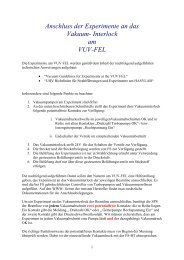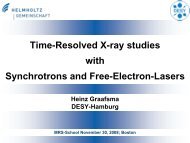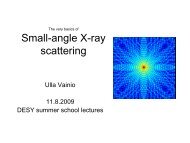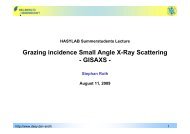The OTIS Reference Manual - Hasylab
The OTIS Reference Manual - Hasylab
The OTIS Reference Manual - Hasylab
Create successful ePaper yourself
Turn your PDF publications into a flip-book with our unique Google optimized e-Paper software.
Figure 15: Recording of a data output sequence while operating in the multi hit mode. <strong>The</strong><br />
different header, hitmask and drift time sections are alternately greyed for the ease of orientation.<br />
Figure 16: Recording of a data output sequence while operating in the multi hit mode. <strong>The</strong> four<br />
header bytes are followed by 32 drift time bytes. Only the channels 13 and 25 show a valid hit<br />
and drift time code.<br />
28 to 45MHz in which the DLL reliably locks. For the chip temperature of 45 centigrade, which<br />
the design is based upon, the locking frequencies range from 24 to 50MHz.<br />
Data Output Sequences:<br />
Figure 15 shows an exemplary recording of a data output sequence of the <strong>OTIS</strong> chip while operating<br />
in the multi hit or plain hitmask mode. <strong>The</strong> visible section of the recording spans 50 clock cycles<br />
and between the markers G1 and G2 the data from 36 clock cycles is shown. Next to the eight<br />
data bits that are labeled from Data 0 (LSB) to Data 7 (MSB), the figure additionally presents<br />
the DataValid signal plus the two service pad signals that are programmed to indicate start and<br />
stop of any data transfer. While the service pads only provide signals for monitoring purposes,<br />
20










